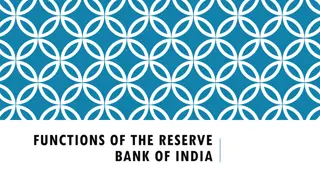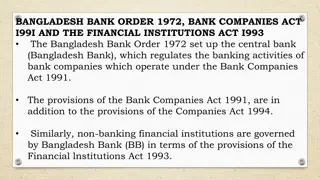
Understanding Commercial Banks and Nationalization in India
Explore the functions of commercial banks, the concept of nationalization in India, and the objectives behind nationalizing banks to prevent monopolies, ensure regional development, and curb corruption. Learn about the historical context and significance of nationalization in the Indian banking sector.
Download Presentation

Please find below an Image/Link to download the presentation.
The content on the website is provided AS IS for your information and personal use only. It may not be sold, licensed, or shared on other websites without obtaining consent from the author. If you encounter any issues during the download, it is possible that the publisher has removed the file from their server.
You are allowed to download the files provided on this website for personal or commercial use, subject to the condition that they are used lawfully. All files are the property of their respective owners.
The content on the website is provided AS IS for your information and personal use only. It may not be sold, licensed, or shared on other websites without obtaining consent from the author.
E N D
Presentation Transcript
Definition Definition : Bank is an institution which collects money from those who have in spare or who are saving it out of their income ; and lend this money out to those who require it. All those institutions which are in the business of banking are called financial institutions.
Yes Commercial Banks are the most important credit institutions in the country in the business of lending and borrowing of money and credit creation
Functions of Commercial Banks Accepting deposits Advancing Loans Discounting Bills of exchange Agency services General services
What is Nationalization of banks The process of transferring ownership and operational rights of a bank from private or trusts to the government of the country. In India also, 14 leading banks were nationalized on July 18, 1969. Each one s deposits were more than Rs 50 crores. Their share in total deposits and advances were almost two third of all scheduled banks in nation
Nationalization of banks in India Nationalized banks were forced to follow directions and guidelines issued by government. At that time there were more than 645 banks having more than 4800 branches. They were serving only urban areas, big industrial houses at the cost of rural areas and small industries
Indira Gandhi was the then P.M. 6 more banks were nationalized in 1980. National credit council was implementing body. In 1993 two banks were nationalized and no. of nationalized banks is 19
Objectives Of Nationalization continues To reduce concentration of economic powers with only a few industrial magnets and to prevent monopolies. Mobilize resources even from backward and rural areas To prevent lopsided regional development To prevent corruption and misuse of firms: the trustees were only benefiting from huge resources and it was at the cost of general development in the country
Objectives Of Nationalization continues To provide aid to the poor, small artisans and small scale industries. Small scale industries contributed 40% of industrial output but received only 4% of bank funds. To fulfil credit needs of farmers: hardly 2.2% of funds were available for agriculture.
Objectives Of Nationalization continues To finance government s development projects; specially five year plans To prevent giving loans to those firms were not existing in the priority list To prevent loan/advances to black marketers and hoarders.
Promotion of new entrepreneurship: Banks have been actively financing IRDP, NREP, TRYSEM, JRY, NRY. The banks have been lending to the high priority projects in the economy






















